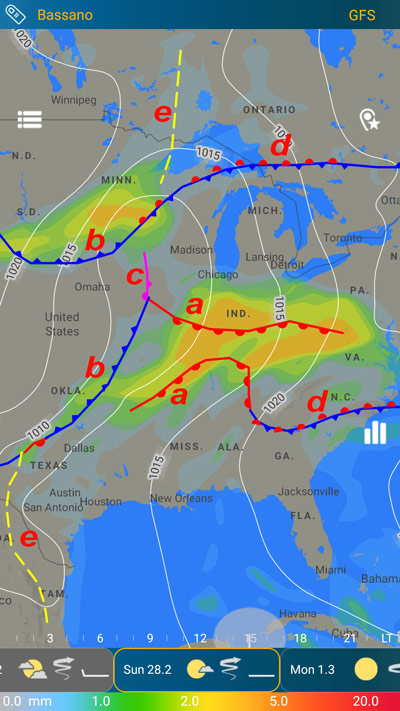a) warm front
b) cold front
c) occlusion front
d) static queue
e) surface trough

An explanation of the different types of weather fronts and their importance to aviation
a) Warm Front: A warm front occurs when warm air replaces cold air as it advances. The warm air rises gradually over the cooler air, leading to the formation of clouds and precipitation along the front. In terms of aviation, flying along or near a warm front can result in prolonged periods of steady rain or drizzle, reduced visibility, and low cloud ceilings.
b) Cold Front: A cold front develops when a mass of cold air displaces warmer air. Cold fronts are associated with rapidly advancing, dense, and cooler air, leading to the formation of cumulonimbus clouds, showers, and thunderstorms. These weather conditions can present challenges to aviation, including turbulence, strong winds, heavy precipitation, and rapid changes in temperature.
c) Occlusion Front: An occlusion front occurs when a faster-moving cold front overtakes a slower-moving warm front, lifting the warm air above the ground. This process creates a complex system of clouds, precipitation, and atmospheric instability. Flying near an occlusion front can bring a mix of weather conditions, including showers, thunderstorms, and areas of low visibility.
d) Stationary Front: A stationary front forms when neither warm nor cold air masses are advancing significantly, resulting in little to no horizontal movement. Along a stationary front, clouds and precipitation can persist for an extended period. Aviation impacts near a stationary front can include areas of low cloud cover, reduced visibility, and steady precipitation.
e) Surface Trough: A surface trough is an elongated area of low pressure extending from a larger low-pressure system. It can be associated with unsettled weather conditions, including the development of showers or thunderstorms. Flying near a surface trough can bring the risk of convective activity, turbulence, and rapidly changing weather conditions.
It's important for pilots and aviation professionals to closely monitor meteorological fronts as they can significantly affect flight operations. The associated weather conditions, such as turbulence, thunderstorms, and reduced visibility, pose potential risks that need to be carefully considered during flight planning and execution.